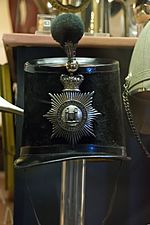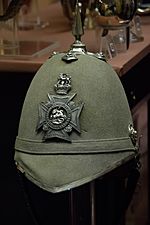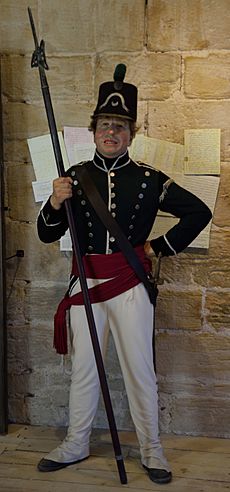Militia and Volunteers of Northumberland facts for kids
The Militia and Volunteers of Northumberland were special military groups from the county, separate from the main British Army. The "modern" Militia started with new laws during the Seven Years' War. The Volunteers changed forms and existed at different times until they became a permanent group in 1859.
Contents
Militia: Northumberland's Home Defenders
Quick facts for kids Northumberland Militia |
|
|---|---|

Officer's Shako (hat) of the Northumberland Light Infantry Militia 1855–1861. From the Royal Northumberland Fusiliers Museum, Alnwick Castle.
|
|
| Active | 1759–1908 |
| Country | Great Britain United Kingdom |
| Branch | Militia |
| Type | Infantry |
| Size | One Battalion Two from June 1798 to November 1799 |
| Nickname(s) | Northumberland Buffs |
| Colours | Facing colour: Buff until 1881 Gosling green |
| Engagements | Gordon riots Second Boer War |
| Disbanded | 1953 |
After a scare in 1745 and the strain on the regular army during the Seven Years' War, new laws were made for the militia. In 1759, a law was passed to choose men from each county by a "ballot" (a type of lottery). Men aged 18 to 50 were eligible.
If a man was chosen, he could pay £10 to have someone else take his place. This meant that poorer people often had to serve. There were riots in 13 counties because people worried about pay and serving overseas. The militia was only supposed to be used in England and Wales.
One riot happened in Hexham in June 1761. About 5,000 people faced six companies of the North York Militia. Sadly, 51 people died and 300 were hurt. When not called for active service, the men had to train for 28 days each year by 1762. Over time, the laws changed to allow them to serve in more parts of the country. They could also volunteer for the regular army.
The Lord Lieutenant of the county was in charge of the militia. Local wealthy people became officers. Their rank depended on how much property they owned. For example, a colonel needed an income of £400 a year.
Northumberland Militia: Early Years and Conflicts
The Northumberland Militia regiment formed in 1759. Sir Edward Blackett Bart. led it, and it had 560 men. Its main base was in Alnwick.
The militia was called into service during several important times:
- Seven Years' War (1760-1762): They were stationed in Berwick-upon-Tweed.
- American Revolutionary War (1778-1782): When France joined the Americans, the militia was called up. Hugh Percy, 2nd Duke of Northumberland commanded them. Their uniforms had buff-colored waistcoats, which gave them the nickname Northumberland Buffs.
* In June 1780, they marched to London to help during the Gordon Riots. They were praised for only firing on looters and people setting fires. They later moved to Dorking and then Southampton before returning home.
- French Revolutionary Wars (1792-1802): The regiment helped keep order and defended against invasion. They were moved around to prevent them from becoming too friendly with local people. By 1798, the regiment had 1,300 men.
* A second battalion, the Northumberland Supplemental Militia, was also raised. Many men from the regiment transferred to the regular army during this time.
- Napoleonic Wars (1803-1814): After a short peace, the regiment was called up again with 649 men. They spent two years in northeast England, then helped stop smuggling in Kent.
* In 1810, they guarded French prisoners of war. Each man even gave a day's pay to help British prisoners. * In 1811, they volunteered to serve in Ireland. They were given the special title of Northumberland Light Infantry Militia. They arrived in Cork in August. * They returned to England in 1813 and were disbanded in Alnwick in 1814. During this time, 1,159 men volunteered for the regular army or Royal Navy.
Training for chosen men started again in 1820, but many men deserted. Training became less frequent after 1831, and the militia movement slowed down.
In 1852, a new law brought the militia back. Men could volunteer (and get a payment of six guineas), but the ballot system was still an option. The 27th Northumberland Light Infantry Militia was commanded by the Earl of Beverly. The first training had 850 men out of 1,122 who had signed up.
During the Crimean War, they were called up from 1855 to 1856. In 1856, 395 men transferred to the regular army. By 1859, fewer men were interested in joining the militia. The rise of new Volunteer forces meant more competition for soldiers. Also, local police forces (constabularies) meant the militia was less needed for keeping order.
Militia: Changes and New Roles
New laws made it easier for militia officers and men to join the regular army. The militia became more of a support group for the main army regiments. In 1881, the Northumberland Light Infantry Militia became the 3rd (Militia) Battalion, The Northumberland Fusiliers.
For the first time, the militia battalion saw action during the Second Boer War. The 3rd battalion was called up in December 1899. Of its 412 officers and men, 151 went to South Africa to help the 2nd Battalion of the Northumberland Fusiliers. The rest guarded Boer prisoners in Malta. The South Africa group lost 23 men to disease and fighting.
In 1908, due to the militia's resistance to more changes, their role became mainly finding and training new soldiers. Renamed the 3rd (Reserve) Battalion, they took over running the regimental Depot. They served in this role during World War I. After the war, they were not reformed and were officially disbanded in 1953.
Artillery Militia: Coastal Defenders
| Northumberland Artillery Militia | |
|---|---|
| Active | 1864–1909 |
| Country | Great Britain United Kingdom |
| Branch | Militia |
| Type | Artillery |
| Size | Five Batteries by 1874 Six in 1882 |
| Disbanded | 1909 |
The Northumberland Artillery Militia was formed in 1854 to defend the coast. It was first based on Tyneside, then in Berwick-upon-Tweed. It started with 161 men in two batteries, later growing to six batteries.
During the Crimean War, a group of about 30 militiamen rioted in North Shields in May 1860. This happened after two of them were threatened with jail for a drunken fight. The townspeople asked for the militia to be moved, and the headquarters moved to Berwick upon Tweed in 1861.
In 1882, it was renamed the 3rd Brigade, Northern Division, Royal Artillery. It was renamed again in 1889 to the Northumberland Artillery (Western Division) Royal Artillery. After serving full-time for a short period in 1900, it was renamed the Northumberland Royal Garrison Artillery (Militia). It was transferred to the field artillery in 1908 and disbanded in 1909.
Volunteers: Citizens Stepping Up
| Northumberland Volunteers | |
|---|---|

Service helmet of an officer of the 1st Volunteer Battalion Northumberland Fusiliers 1883–1893. From the Royal Northumberland Fusiliers museum, Alnwick Castle
|
|
| Active | 1758–1908 |
| Country | Great Britain United Kingdom |
| Branch | Volunteers |
| Type | Artillery, Cavalry, Infantry |
| Size | Multiple platoon to company and battalion sized units 1794–1816 Three battalions 1861–1908 |
| Engagements | Second Boer War |
| Disbanded | 1968 |
In 1778, a law allowed volunteers to join the militia, but not many did. In 1782, a new law allowed local groups to raise volunteer forces. Wealthy landowners or business people often paid for most of the costs. The government would pay them for service and allow the men to be judged by volunteer officers.
Volunteer Corps: Local Groups Formed
Volunteer recruitment was slow at first during the Revolutionary wars. It picked up after a 1798 law allowed "Armed Associations" to be formed. These groups were also funded by local donations, with wealthy people often leading them. The leader's rank depended on the number of men in the group.
Early groups (1794-1795) included:
- The Loyal Newcastle Volunteers: 300 to 400 men, self-funded. They were called the Tinsel Dons because of their bright uniforms.
- The Newcastle Armed Association: 800 to 1,000 men, supported by the government.
- The Loyal Berwick Volunteers: Four companies strong by 1797.
Other units formed from 1798 onwards:
- The Hexham Volunteer Infantry.
- The Morpeth Associated Volunteer Infantry: 125 men in 1801.
- The Wallington and Kirkharle Volunteer Troop of Cavalry.
- The Corbridge Volunteer Corps of Infantry: Formed in 1804, with red uniforms and yellow facings.
- The Seaton Delaval Associated Corps of Volunteer Infantry: 72 men, funded by Lord Delaval.
- The Cheviot Legion: Combined infantry and cavalry. They were called the Royal Cheviot Legion after turning out quickly during an invasion scare in 1804.
- The Coquetdale Rangers: Formed in 1799 and lasted until 1821.
- The Coquetdale Troop of Volunteer Cavalry.
- The Loyal Glendale Rangers: Re-formed in 1803 as the larger Glendale Volunteer Infantry and Glendale Volunteer Cavalry.
- The North Shields and Tynemouth Volunteer Infantry.
- The Wallsend Volunteer Rifle Corps: Trained as light infantry, wearing green uniforms.
- The Berwick Gentlemen Independent Volunteers: 89 men who served without pay.
- The Berwick Volunteer Artillery.
- The Bywell Volunteer Yeomanry Cavalry.
The largest group was the Percy Tenantry Volunteers. Hugh Percy, 2nd Duke of Northumberland raised them in 1798 from his estates. They included infantry and cavalry. When volunteers reformed in 1803, their strength grew to 304 cavalrymen and 1,195 infantrymen.
In 1805, a Percy Tenantry Volunteer Artillery Company was formed. They used two brass cannons. This artillery group continued even after the other tenantry groups disbanded in 1814. They became the core of the 2nd Northumberland (Percy) Artillery Volunteers in 1860.
Local Militia: Merging Forces
Because there were many small volunteer units, and some had radical political ideas, they were encouraged to merge. This happened as the government slowly stopped funding them. Three regiments of the Northumberland Local Militia were formed:
- Northern Regiment: Based at Alnwick, with 761 men.
- Western Regiment: Based at Hexham, with 788 men.
- Southern Regiment: Based at Morpeth, with 765 men.
The volunteer groups far from these main locations continued to exist. None of these groups were called out for service, except for a false alarm in 1804. By 1818, all the infantry, cavalry, and artillery volunteers had disbanded.
Yeomanry: Keeping the Peace
In 1819, after the war ended, there was economic unrest. Landowners and business people formed a group called the Northumberland and Newcastle Volunteer Corps of Cavalry. This group helped the police keep the peace many times. For example, in 1822, they were on duty for 23 days during strikes and riots by Tyne boatmen.
Their annual training became a big social event for the upper classes in the North-East. The corps' role became more about ceremonies and social gatherings. In 1876, the corps was renamed the Northumberland Hussars. During the Boer War, 355 men from the Northumberland Hussars and other volunteers served in South Africa.
Rifle Volunteers: New Citizen Soldiers
In 1859, another invasion scare led the government to ask counties to raise volunteer corps. To encourage this, the government gave 25 Long Enfield rifles for every 100 volunteers. A corps needed 60 men to be officially formed. Members had to pay a subscription, usually 10 shillings a year.
Since these volunteer corps were mostly made up of middle-class people, they competed with the militia for members. This meant the militia became mostly for working-class people.
New volunteer corps formed between 1861 and 1878 included:
|
|
In August 1861, these groups formed the 1st and 2nd Administrative Battalions of the Northumberland Rifle Volunteers. The large 1st Newcastle upon Tyne Rifle Volunteer Corps formed another battalion.
Volunteer Artillery: Supporting the Coast
Alongside the Rifle Volunteers, Artillery Volunteers were also formed:
- 1st Northumberland (Tynemouth) Artillery Volunteers: Formed in August 1859 in Tynemouth. They practiced with old cannons at Tynemouth Castle. By the late 1870s, they had six batteries. During the Boer War, they sent 130 men to the Elswick Battery, which was the only Volunteer Artillery unit to serve there.
- 2nd Northumberland (Percy) Artillery Volunteers: Formed in February 1860 from the old Duke's Tenantry Artillery. They practiced with a 32-pounder cannon near Alnmouth. In 1882, a group from this corps won several awards in a competition. In 1901, they were renamed 2nd Northumberland (Percy) Royal Garrison Artillery Volunteers. They were disbanded in 1902.
- 3rd Northumberland (Newcastle) Artillery Volunteers: Formed in Spring 1860. They quickly grew to six batteries by 1863. They used 18 and 24-pounder cannons.
- 1st Berwick-on-Tweed Artillery Volunteer Corps: Formed in February 1859, with two batteries.
Volunteer Engineers: Building and Innovating
In September 1860, a Corps of Engineer Volunteers was formed. It was made up of men from the Armstrong factories at Elswick and joined the Newcastle Rifle Volunteers. This group eventually became the 1st Newcastle Engineers.
Volunteers: Reorganization and Amalgamation
After 1873, the volunteer groups were linked with the militia and regular army, but they still didn't interact much. In 1881, the Administrative battalions were renamed:
- 1st Administrative Battalion, Northumberland Rifle Volunteers became Northumberland & Berwick upon Tweed Volunteers.
- 2nd Administrative Battalion Northumberland Rifle Volunteers became 2nd Northumberland Volunteer Battalion.
- 1st Newcastle upon Tyne Rifle Volunteer Corps became 1st Newcastle Volunteer Battalion.
In 1881, the regular army, militia, and volunteers were all joined into the Northumberland Fusiliers. Regular officers started working as adjutants (assistants) for the volunteer battalions. This created a closer link to the regular army. In 1887, the Rifle Volunteers were renamed as Volunteer Battalions of the Northumberland Fusiliers and numbered:
- Northumberland & Berwick upon Tweed Volunteers became 1st Volunteer Battalion.
- 2nd Northumberland Volunteer Battalion became 2nd Volunteer Battalion.
- 1st Newcastle Volunteer Battalion became 3rd Volunteer Battalion.
Around this time, annual battalion camps became common. During the Boer War, each of the three battalions sent 70 to 80 volunteers to South Africa. These groups greatly strengthened the connections between the volunteers and the county regiment. A new invasion scare also caused a big increase in volunteer numbers.
Haldane Reforms: A New Era
As part of reforms, volunteers received more financial support. In return, they had to attend a regular annual camp and train for six months if called up. The volunteer battalions came under the control of the new county association. As these reforms were announced, fewer people joined the volunteers.
On March 31, 1908, the Volunteer Force was officially ended. The next day, the Territorial Force was created. The volunteer battalions were renumbered after the old militia battalion. The 1st Volunteer Battalion was split to form the 4th and 7th battalions. They became the 4th to 7th Battalions of the Northumberland Fusiliers. These were part of the Northumberland Brigade, which was part of the Northumbrian Division.
On this same day, the 1st (Tynemouth) Volunteer Artillery became the Tynemouth Garrison Artillery. The remaining volunteer artillery groups from Northumberland and County Durham became the artillery brigades of the Northumbrian Division.


